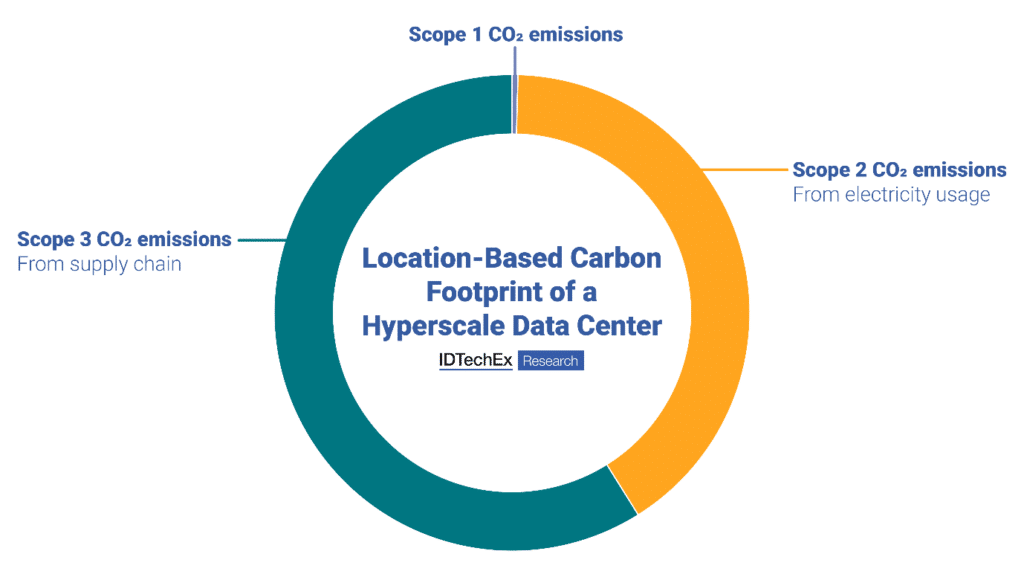Scope 2 power-based emissions and Scope 3 supply chain emissions make the biggest contribution to the data center’s carbon footprint. IDTechEx’s Sustainability for Data Centers report explores which technologies can reduce these emissions.
Major data center players converged in London, UK, in the middle of March for the 2025 iteration of Data Centre World. Co-located with events such as Cloud & AI Infrastructure, DevOps Live, Cloud & Cyber Security Expo, and Big Data & AI World, the event boasted over 10,000 attendees and 300+ exhibitors. Presenters and exhibitors touched on many relevant themes from IDTechEx‘s “Sustainability for Data Centers 2025-2035: Green Technologies, Market Forecasts, and Players” and “Thermal Management for Data Centers 2025-2035: Technologies, Markets, and Opportunities” reports. In this article, IDTechEx explores three key insights from Data Centre World.
Energy efficiency is highest design priority
The most successful sustainable data center technologies will also improve economic viability. For example, operational costs are lowered when energy efficiency is improved, while simultaneously reducing scope 2 power-based CO2 emissions. Speaking at Data Centre World, Vertiv’s Alessandro Zerbetto reported, “Energy efficiency is the highest priority for Vertiv in the design phase”.
Innovations in data center cooling technologies have been particularly impactful in reducing wasted energy as the industry transitions from air cooling to liquid cooling. As of 2025, single-phase direct-to-chip cooling dominates the high-end GPU thermal management market. However, with the increasing thermal design power, demand for two-phase direct-to-chip cooling will continue to grow.
Sustainable data centers go beyond PUE
Not many policies currently exist that can drive data center decarbonization. Where such policies have been introduced, they usually specifically restrict PUE (power usage effectiveness). A good PUE means most of the energy goes towards the IT facilities in data centers and is not “wasted” for cooling or auxiliary systems.
However, as pointed out by Babak Falsafi (President of the Swiss Data Center Energy Efficiency Association) in his presentation at Data Center World, PUE measures energy allocation but does not measure how efficiently the IT equipment itself is used within the data center. A data center with a good PUE can still have inefficient or underutilized servers. Moreover, PUE does not reflect any heat recycling or on-site renewable energy generation and ignores the carbon intensity of the power delivered to a data center. Clearly, the development of sustainable data center technologies needs to go beyond PUE. As Falsafi put it “if PUE was the answer, we wouldn’t still be talking about data center sustainability”.
Investment interest in AI is shifting
Over the past few years, huge sums of money have been invested in researching AI LLMs (large language models). It can take billions of dollars to train a model as of 2025. However, according to some presentations at Data Centre World, it is not yet clear where ROI (return-on-investment) for AI will come from, and some in the industry have drawn parallels to the dot-com bubble of the early 2000s.
Therefore, investment interest is shifting towards finding use cases for AI and away from continually pouring money into LLMs. This has only been further catalysed by Deep Seek, which proved that high levels of performance can be achieved with much lower training costs and reduced power demand. Once killer applications can be identified for AI, ROI will become much clearer.
The bigger picture
Sustainable technologies that can improve the energy efficiency of data centers and, therefore, also simultaneously reduce operational costs are already seeing success. However, there are many facets to sustainable data centers. Discussions need to go beyond PUE and consider the carbon intensity of power grids (determined by the number of renewable energy projects feeding into it). Additionally, scope 3 supply chain emissions of data centers must be addressed. This may become more challenging against the backdrop of Trump’s tariffs and increasing supply chain uncertainty.
Even beyond sustainability, the rapid scale-up of data centers will face other barriers. For many locations, electricity grids are under strain, and securing power for new data centers has become slow and difficult. Moreover, the uncertain ROI of AI may shake investor confidence.
IDTechEx’s research reports, “Sustainability for Data Centers 2025-2035: Green Technologies, Market Forecasts, and Players” and “Thermal Management for Data Centers 2025-2035: Technologies, Markets, and Opportunities” provide intelligence on key technologies and markets in the data center space.
For the full portfolio of these topics, please visit:
Eve Pope
Technology Analyst, IDTechEx
About IDTechEx
IDTechEx provides trusted independent research on emerging technologies and their markets. Since 1999, we have been helping our clients to understand new technologies, their supply chains, market requirements, opportunities and forecasts. For more information, contact [email protected] or visit www.IDTechEx.com.


